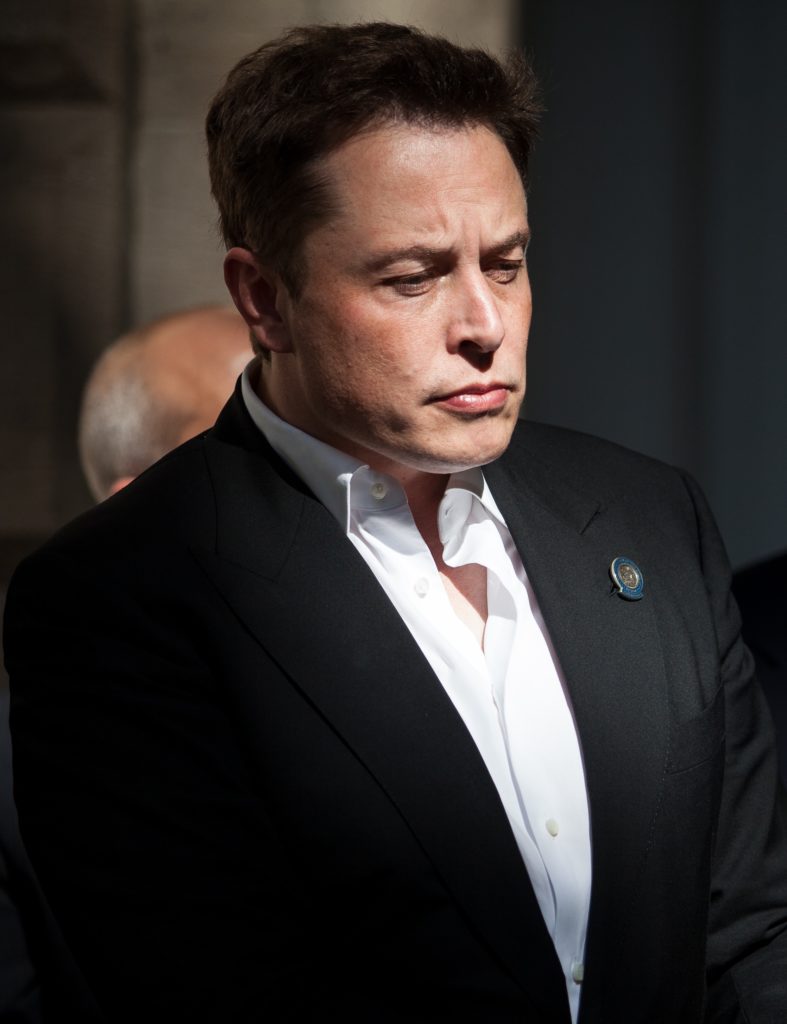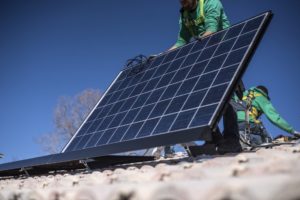News
Elon Musk: The King of Job Creation

Since the launch of Tesla, SpaceX and SolarCity, serial tech entrepreneur Elon Musk’s companies have consistently created thousands of high paying jobs worldwide. SpaceX has grown from a small team of engineers working out of a warehouse to a global team of over 5,000 employees. Similarly, Tesla has gone from a garage operation in Palo Alto to an operation consisting of over 18,000 employees worldwide. SolarCity, backed by Musk and founded by his cousins, was acquired in 2016 by Tesla and employs over 12,000 workers.
Musk’s role in job creation has has had a deep impact on thousands of lives, and on a global scale. Between all of his companies, Musk employs over 35,000 employees globally, of which 30,000+ are in the US.
Advanced Manufacturing: Tesla
 Since Tesla began production of the Roadster in 2008, the company has been able to put more than 190,000 electric vehicles on the road and reduce vehicle emissions on a global level. In addition to the environmental contributions, Tesla’s economic activities have spanned far and wide, leading to the coined term, “The Tesla Effect.”
Since Tesla began production of the Roadster in 2008, the company has been able to put more than 190,000 electric vehicles on the road and reduce vehicle emissions on a global level. In addition to the environmental contributions, Tesla’s economic activities have spanned far and wide, leading to the coined term, “The Tesla Effect.”
“I define the ‘Tesla effect’ as a positive shift toward changing Reno’s national perception for the better. The New York Times, Wall Street Journal, Bloomberg Business, and many other national publications have written about Reno’s emerging neighborhoods, such as Midtown, downtown, and the Fourth Street corridor. And this is due in large part to our booming technology industry with billions of dollars being invested from some of Fortune’s highest-ranked companies, which includes Tesla, Switch, Amazon, and Microsoft.” said Reno Mayor Hillary Schieve in a comment to Teslarati.
Reno has seen a complete boom in job growth and a resurgence in the housing market near Tesla’s $5 billion Gigafactory facility. Reno expects to gain 80,000 indirect jobs created through recent developments (20-30k indirectly from the Gigafactory) and host to 40,000 homes expected to be constructed by 2020. Tesla’s effects on the market could even create a “housing crisis” as builders struggle to build enough homes to meet demand according to Mike Kazmierski, president of the Economic Development Authority of Western Nevada.
In Reno alone, Tesla has created 1,000 full-time local jobs at the Gigafactory and over 1,900 construction jobs. A Tesla spokesperson tells us that the company expects to hire another 1,000 employees in the first half of 2017 while strategic partner Panasonic expects to hire 2,000 workers at the factory. Tesla expects to employ 6,500 full-time employees at the facility in 2018 and as many as 10,000 once the Gigafactory hits peak production
Engineering the Future: SpaceX
SpaceX currently employs over 5,000 employees and has operations all across the country. The company has been in hyper-growth mode for over a decade and has launched 29 rockets successfully into space to date. The company currently has over 800 job openings which is expected to increase as the company prepares for a busy year to come.
Thousands of skilled labor jobs: SolarCity (now part of Tesla Inc.)
SolarCity was founded in 2006 by Musk’s cousins Peter and Lindon Rive and financially backed by an initial $10M investment from Musk. Since then, the company has completed projects in 27 states which includes solar installations for over 300,000 customers, making up over 2.5GW of solar.
SolarCity employs over 12,000 workers and has nearly 1,900 job openings posted on their site. The company plans to start producing its own solar cells and solar roof panels in the second half of 2017 from its Buffalo, NY plant. The plant plans to employ more than 1,400 people as they prepare to begin production later this year.
Overall, Musk has played a crucial role in job creation in the 21st century as his companies look to surpass 40,000 jobs created this year. This makes Musk one of the most significant voices on the White House’s Manufacturing Jobs Council as he continues to create thousands of high-paying jobs in the US. Musk’s companies have a combined total of 4,800+ job openings globally.

News
Tesla China quietly posts Robotaxi-related job listing
Tesla China is currently seeking a Low Voltage Electrical Engineer to work on circuit board design for the company’s autonomous vehicles.

Tesla has posted a new job listing in Shanghai explicitly tied to its Robotaxi program, fueling speculation that the company is preparing to launch its dedicated autonomous ride-hailing service in China.
As noted in the listing, Tesla China is currently seeking a Low Voltage Electrical Engineer to work on circuit board design for the company’s autonomous vehicles.
Robotaxi-specific role
The listing, which was shared on social media platform X by industry watcher @tslaming, suggested that Tesla China is looking to fill the role urgently. The job listing itself specifically mentions that the person hired for the role will be working on the Low Voltage Hardware team, which would design the circuit boards that would serve as the nervous system of the Robotaxi.
Key tasks for the role, as indicated in the job listing, include collaboration with PCB layout, firmware, mechanical, program management, and validation teams, among other responsibilities. The role is based in Shanghai.
China Robotaxi launch
China represents a massive potential market for robotaxis, with its dense urban centers and supportive policies in select cities. Tesla has limited permission to roll out FSD in the country, though despite this, its vehicles have been hailed as among the best in the market when it comes to autonomous features. So far, at least, it appears that China supports Tesla’s FSD and Robotaxi rollout.
This was hinted at in November, when Tesla brought the Cybercab to the 8th China International Import Expo (CIIE) in Shanghai, marking the first time that the autonomous two-seater was brought to the Asia-Pacific region. The vehicle, despite not having a release date in China, received a significant amount of interest among the event’s attendees.
Elon Musk
Elon Musk and Tesla AI Director share insights after empty driver seat Robotaxi rides
The executives’ unoccupied tests hint at the rapid progress of Tesla’s unsupervised Robotaxi efforts.

Tesla CEO Elon Musk and AI Director Ashok Elluswamy celebrated Christmas Eve by sharing personal experiences with Robotaxi vehicles that had no safety monitor or occupant in the driver’s seat. Musk described the system’s “perfect driving” around Austin, while Elluswamy posted video from the back seat, calling it “an amazing experience.”
The executives’ unoccupied tests hint at the rapid progress of Tesla’s unsupervised Robotaxi efforts.
Elon and Ashok’s firsthand Robotaxi insights
Prior to Musk and the Tesla AI Director’s posts, sightings of unmanned Teslas navigating public roads were widely shared on social media. One such vehicle was spotted in Austin, Texas, which Elon Musk acknowleged by stating that “Testing is underway with no occupants in the car.”
Based on his Christmas Eve post, Musk seemed to have tested an unmanned Tesla himself. “A Tesla with no safety monitor in the car and me sitting in the passenger seat took me all around Austin on Sunday with perfect driving,” Musk wrote in his post.
Elluswamy responded with a 2-minute video showing himself in the rear of an unmanned Tesla. The video featured the vehicle’s empty front seats, as well as its smooth handling through real-world traffic. He captioned his video with the words, “It’s an amazing experience!”
Towards Unsupervised operations
During an xAI Hackathon earlier this month, Elon Musk mentioned that Tesla owed be removing Safety Monitors from its Robotaxis in Austin in just three weeks. “Unsupervised is pretty much solved at this point. So there will be Tesla Robotaxis operating in Austin with no one in them. Not even anyone in the passenger seat in about three weeks,” he said. Musk echoed similar estimates at the 2025 Annual Shareholder Meeting and the Q3 2025 earnings call.
Considering the insights that were posted Musk and Elluswamy, it does appear that Tesla is working hard towards operating its Robotaxis with no safety monitors. This is quite impressive considering that the service was launched just earlier this year.
Elon Musk
Starlink passes 9 million active customers just weeks after hitting 8 million
The milestone highlights the accelerating growth of Starlink, which has now been adding over 20,000 new users per day.

SpaceX’s Starlink satellite internet service has continued its rapid global expansion, surpassing 9 million active customers just weeks after crossing the 8 million mark.
The milestone highlights the accelerating growth of Starlink, which has now been adding over 20,000 new users per day.
9 million customers
In a post on X, SpaceX stated that Starlink now serves over 9 million active users across 155 countries, territories, and markets. The company reached 8 million customers in early November, meaning it added roughly 1 million subscribers in under seven weeks, or about 21,275 new users on average per day.
“Starlink is connecting more than 9M active customers with high-speed internet across 155 countries, territories, and many other markets,” Starlink wrote in a post on its official X account. SpaceX President Gwynne Shotwell also celebrated the milestone on X. “A huge thank you to all of our customers and congrats to the Starlink team for such an incredible product,” she wrote.
That growth rate reflects both rising demand for broadband in underserved regions and Starlink’s expanding satellite constellation, which now includes more than 9,000 low-Earth-orbit satellites designed to deliver high-speed, low-latency internet worldwide.
Starlink’s momentum
Starlink’s momentum has been building up. SpaceX reported 4.6 million Starlink customers in December 2024, followed by 7 million by August 2025, and 8 million customers in November. Independent data also suggests Starlink usage is rising sharply, with Cloudflare reporting that global web traffic from Starlink users more than doubled in 2025, as noted in an Insider report.
Starlink’s momentum is increasingly tied to SpaceX’s broader financial outlook. Elon Musk has said the satellite network is “by far” the company’s largest revenue driver, and reports suggest SpaceX may be positioning itself for an initial public offering as soon as next year, with valuations estimated as high as $1.5 trillion. Musk has also suggested in the past that Starlink could have its own IPO in the future.










